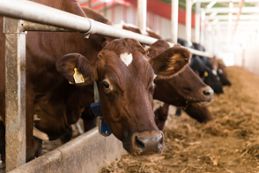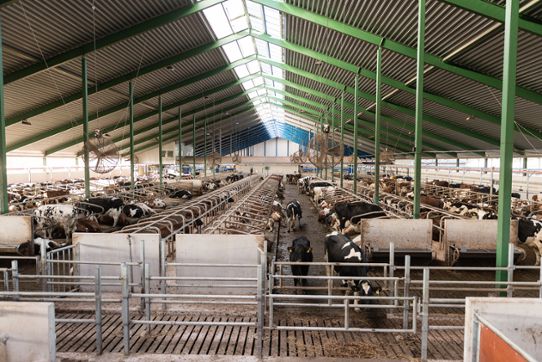The cousins Milton and Joakim run one of Sweden's largest dairy farms. In 2012, a new loose housing shed was completed on their farm, Hanåsa, to house dairy cows and heifers.
The consequences of heat stress for dairy cows

When temperatures are too high, cows can suffer heat stress, which is when an animal cannot get rid of sufficient excess heat to maintain a normal body temperature. Cows' body temperature is affected by the ambient temperature, as well as by the heat produced through digestion. Consequently, cows deal with high ambient temperatures by eating less and altering other behaviours. This heat stress affects their ability to produce milk and also reduces its fat content.
An insulated and ventilated cowshed
The cowshed built at Hanåsa Farm uses warm loose housing. This means that the cows are not penned in and are able to move freely in an insulated building. The roof is well-insulated, which means that the cowshed is both cooler in summer and maintains heat better in winter.

The long sides and a roof ridge of the cowshed can be opened in order to create natural ventilation. Natural ventilation can be created through both the wind blowing fresh air through the cowshed and the stack effect. The stack effect is when the warmed air in the cowshed rises up and is released through the open roof ridge, which results in fresh air being drawn in from the sides. In addition, circulation fans were installed to further increase the air flow.
Effects
The owners have noticed that after moving into the new cowshed the cows are feeling better and the signs of heat stress have decreased. In addition, the air quality is better and there are far fewer insects in the building than in the old cowshed. The insects are a major source of irritation for the cows and also potential sources of infection.
Financing
Building the new cowshed and updating old sheds cost a total of SEK 74 million. The project received SEK 900 000 in investment support from the Swedish Board of Agriculture and local investment programmes. The cost of the ventilation was not a large proportion of the building's total cost.
More examples of climate adaptation
This is one of many examples of climate adaptation. There are more in the collection of ideas being built up by the Swedish National Knowledge Centre for Climate Change Adaptation at the Swedish Meteorological and Hydrological Institute (SMHI). The collection of examples has the aim of sharing experiences and providing ideas to everyone who works with climate adaptation. Examples describe concrete measures and challenges in several subject areas. They show how different actors have worked to adapt their activities to the climate changes that are already being noticed today and those that we cannot prevent in the future.